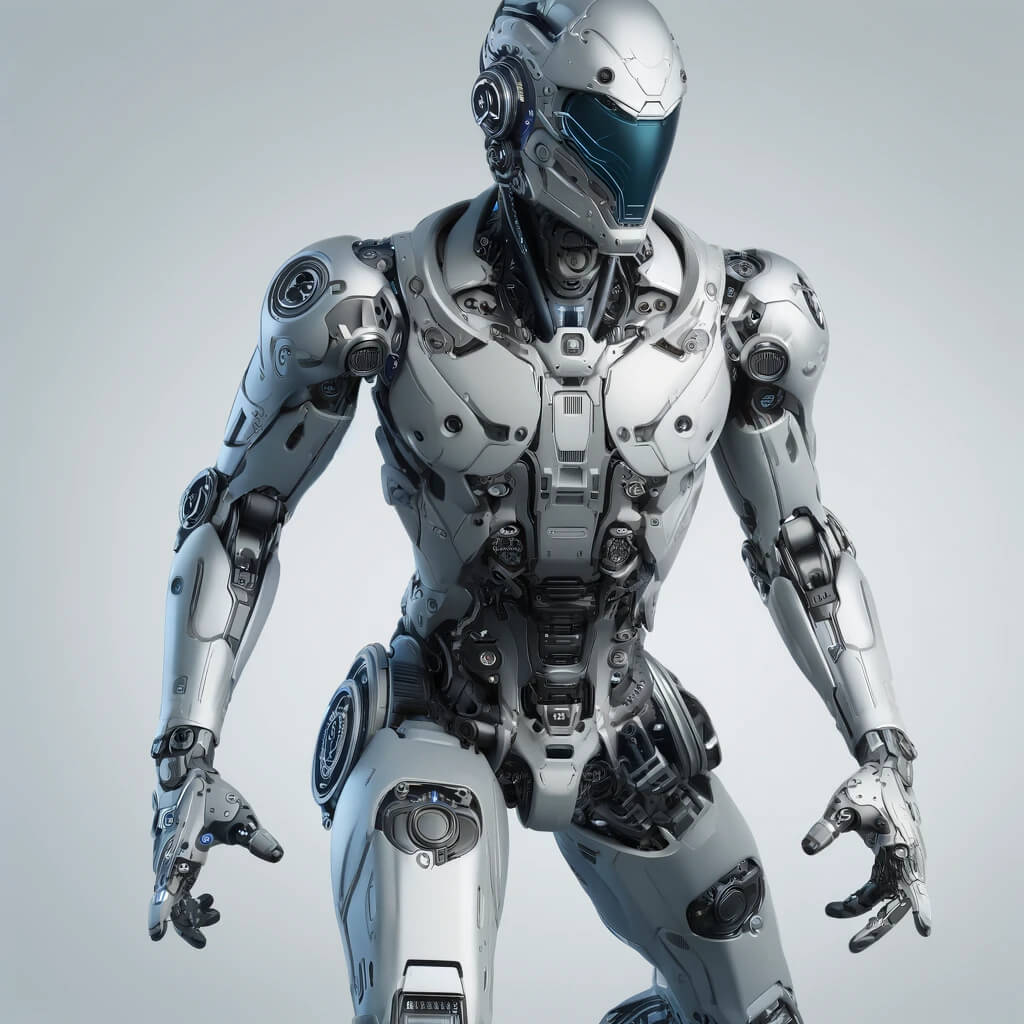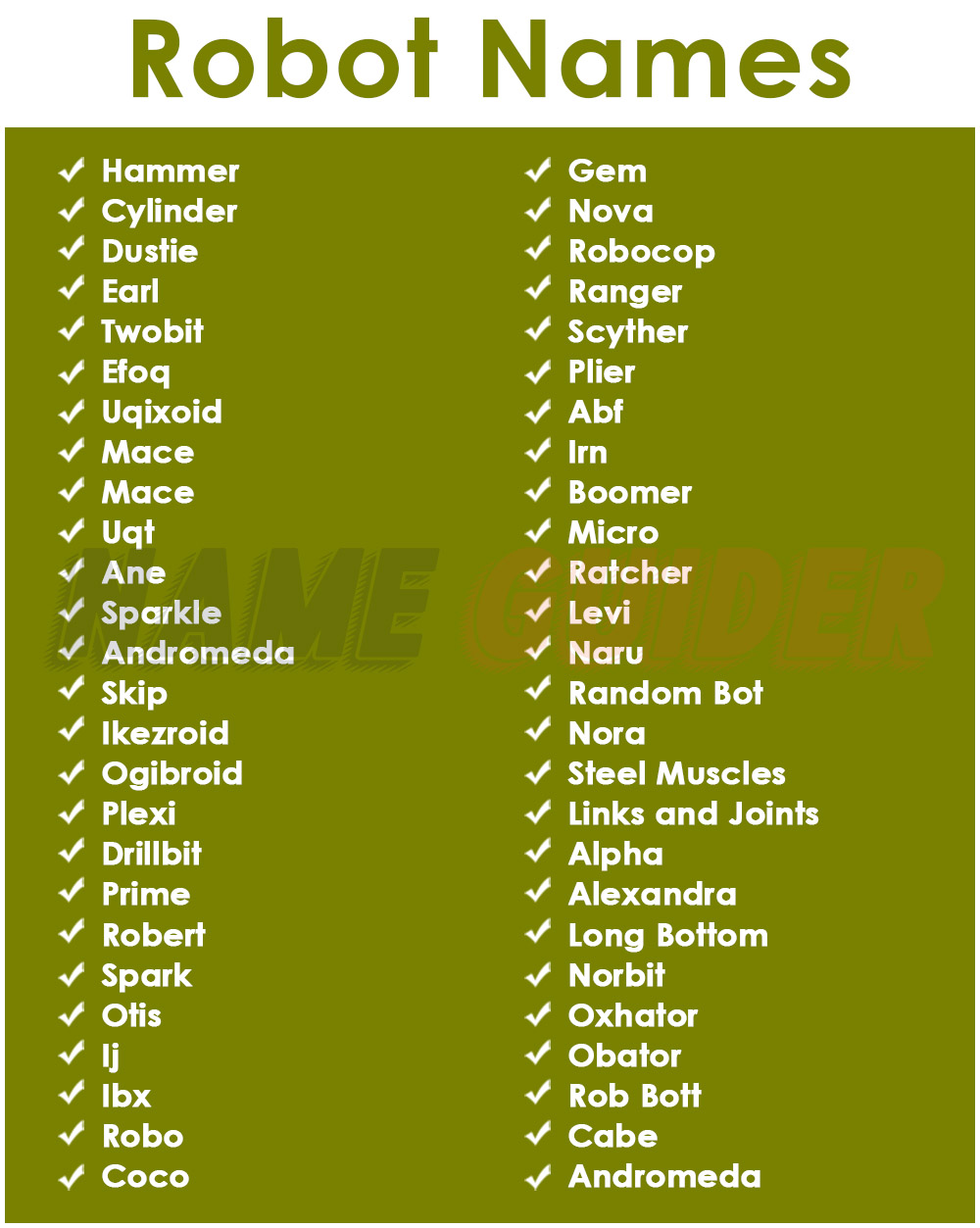Have you ever wondered how to come up with the perfect name for robot? The right name can transform a simple machine into a trusted companion or a powerful tool. Whether you're naming a personal assistant, a manufacturing robot, or even a futuristic AI, the name plays a crucial role in shaping its identity. In this guide, we’ll dive deep into the world of robot naming conventions, trends, and tips to help you pick the best name for your mechanical buddy.
Choosing the right name for a robot isn't just about aesthetics; it's about creating an emotional connection between humans and machines. Think about it – names like "R2-D2" or "WALL-E" have become cultural icons because they resonate with us on a personal level. But how do you create that same magic when naming your own robot? Stick around as we explore everything from historical influences to futuristic trends.
Before we jump into the nitty-gritty details, let’s address one important question: Why does the name matter so much? A good name sets the tone for what the robot represents. It could be sleek and modern, friendly and approachable, or even mysterious and advanced. The possibilities are endless! So, buckle up because we’re about to take you on a journey through the fascinating world of robot naming.
Read also:Connor Cruise Net Worth The Rising Stars Financial Journey
Understanding the Importance of Robot Names
Why Names Matter for Robots
A name is more than just a label; it's a reflection of purpose, personality, and function. When naming a robot, you’re essentially defining its role in society. For instance, robots designed for healthcare might need names that convey trust and reliability, while those built for entertainment should feel playful and engaging. This is why companies spend countless hours brainstorming the perfect name for their creations.
Let’s look at some examples: "Siri," "Alexa," and "Cortana" all evoke a sense of intelligence and assistance. These names were carefully chosen to make users feel comfortable interacting with artificial intelligence. On the flip side, industrial robots often have technical-sounding names that highlight precision and efficiency. The key takeaway here is that the name must align with the robot's intended use case.
Historical Influences on Robot Names
From Science Fiction to Reality
Science fiction has long been a source of inspiration for robot names. Think about iconic characters like "Data" from Star Trek or "The Terminator." These fictional robots have shaped our expectations of what robots should be called. Interestingly, many real-world robots borrow heavily from sci-fi tropes. For example, Boston Dynamics' "Spot" robot was inspired by the idea of a futuristic canine companion.
But it’s not just about copying pop culture references. Historically, engineers and scientists have also drawn inspiration from mythology, literature, and even nature. Take "Asimo," Honda's humanoid robot, which gets its name from the acronym "Advanced Step in Innovative Mobility." Similarly, NASA’s "Curiosity" rover was named after the human trait of curiosity, emphasizing the robot's mission to explore unknown territories.
Trends in Robot Naming Conventions
Modern Naming Techniques
Today, there are several popular trends in robot naming. One common approach is to use acronyms that describe the robot's capabilities. Another trend involves combining human-like names with technical terms to create hybrid monikers. For example, "Pepper," a social robot developed by SoftBank, combines a friendly name with a nod to its advanced programming.
Here’s a quick breakdown of some popular naming techniques:
Read also:Charleston White Education Unveiling The Path To Empowerment
- Acronyms: Names like "ASIMO" or "PR2" (Personal Robot 2) are concise and professional.
- Human-like Names: Robots like "Sophia" or "Jibo" aim to create a more relatable connection.
- Descriptive Names: These names focus on the robot's function, such as "Roomba" for a vacuum cleaner robot.
- Creative Combinations: Mixing words to form unique names, like "Baxter" or "Fetch."
Factors to Consider When Naming a Robot
Matching the Robot’s Purpose
When brainstorming names for your robot, consider its primary function. Is it designed for education, manufacturing, or personal assistance? Each purpose requires a different naming strategy. For example, educational robots might benefit from whimsical names that appeal to children, while industrial robots should have names that emphasize strength and reliability.
Another factor to consider is the target audience. Will the robot be used by tech-savvy professionals or everyday consumers? Understanding your audience will help you choose a name that resonates with them. Additionally, think about cultural implications. A name that works well in one country might not translate well in another, so it’s important to conduct thorough research before finalizing your choice.
Creative Inspiration for Robot Names
Where to Find Inspiration
If you’re stuck trying to come up with a name for your robot, don’t worry – inspiration can come from anywhere! Here are a few ideas to get you started:
- Nature: Names inspired by animals, plants, or natural elements can add a touch of elegance and simplicity.
- Mythology: Drawing from ancient myths and legends can give your robot a timeless and mysterious quality.
- Pop Culture: Referencing movies, books, or TV shows can create instant recognition and appeal.
- Science and Technology: Incorporating scientific terms or futuristic concepts can emphasize the robot's advanced capabilities.
Remember, the goal is to create a name that feels authentic and meaningful. Don’t be afraid to think outside the box and let your creativity shine!
Popular Robot Names and Their Meanings
Examples of Successful Robot Names
Let’s take a look at some of the most successful robot names and what makes them so effective:
- Siri: Short for Speech Interpretation and Recognition Interface, Siri’s name suggests ease of use and intelligent communication.
- WALL-E: Waste Allocation Load Lifter: Earth-Class – a playful name that fits the robot’s role as a trash-compacting hero.
- Da Vinci Surgical System: Named after the legendary artist and inventor, this robot embodies precision and innovation.
- Pepper: A friendly and approachable name that reflects the robot’s role as a social companion.
These examples show that a great name doesn’t have to be complicated. Sometimes, simplicity is key to creating a memorable identity.
How to Test Your Robot Name
Ensuring Your Name Resonates
Once you’ve come up with a few potential names, it’s important to test them with your target audience. Conduct surveys, focus groups, or even informal polls to gather feedback. Pay attention to how people react to the name – does it evoke the right emotions? Is it easy to pronounce and remember?
Another useful tool is a trademark search. You don’t want to invest time and resources into a name only to discover it’s already taken. Use online databases to check for existing trademarks and ensure your name is unique. Finally, consider the international market. If your robot will be sold globally, make sure the name doesn’t have any negative connotations in other languages.
Legal Considerations for Robot Names
Protecting Your Intellectual Property
When naming a robot, it’s crucial to protect your intellectual property. This means securing trademarks and copyrights for your chosen name. Without proper legal protection, other companies could potentially use your name, leading to confusion and potential legal battles.
Here’s a step-by-step guide to protecting your robot name:
- Conduct a thorough trademark search.
- File for trademark registration with relevant authorities.
- Monitor the market for any unauthorized use of your name.
While this process may seem daunting, it’s an essential step in safeguarding your investment. Many businesses hire legal experts to handle these matters, ensuring everything is done correctly.
Tips for Creating a Memorable Robot Name
Stand Out From the Crowd
With so many robots entering the market, standing out is more important than ever. Here are some tips to help you create a truly memorable name:
- Keep it short and sweet – no one wants to remember a mouthful of syllables.
- Make it easy to pronounce and spell – simplicity is key.
- Use alliteration or rhymes to make the name more catchy.
- Consider the emotional impact – does the name evoke the right feelings?
Remember, the goal is to create a name that sticks in people’s minds long after they’ve interacted with your robot. A well-chosen name can turn a simple machine into a beloved companion.
Final Thoughts: Your Perfect Robot Name Awaits
Choosing the right name for your robot is a journey filled with creativity and discovery. From historical influences to modern trends, there’s no shortage of inspiration to draw from. By considering factors like purpose, audience, and legal implications, you can create a name that truly reflects your robot’s identity.
So, what are you waiting for? Grab a pen and start brainstorming. Who knows – the next big name in robotics could be yours! And don’t forget to share your thoughts in the comments below. We’d love to hear about your naming ideas and experiences.
Table of Contents
- Understanding the Importance of Robot Names
- Historical Influences on Robot Names
- Trends in Robot Naming Conventions
- Factors to Consider When Naming a Robot
- Creative Inspiration for Robot Names
- Popular Robot Names and Their Meanings
- How to Test Your Robot Name
- Legal Considerations for Robot Names
- Tips for Creating a Memorable Robot Name
- Final Thoughts: Your Perfect Robot Name Awaits


